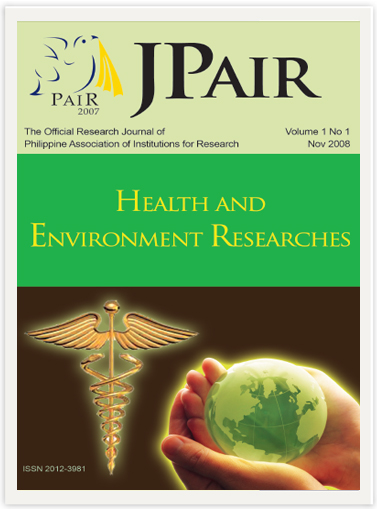A Cross-Sectional Study on the Extent of Fecal Contamination of Cagayan De Oro River along Five Urban Barangays and the Factors Affecting Contamination, October 2007 - January 2008
DOI:
https://doi.org/10.7719/jpair.v1i1.41Keywords:
Focus Contamination, Urban BarangayAbstract
A cross-sectional study was conducted from October 2007 to January 2008 to determine the extent of fecal contamination in Cagayan de Oro River across five urban barangays: Macasandig, Puntod, Macabalan, Carmen, and Marcos Bridge (Consolacion). Using the Multiple Tube Fermentation Technique (MTFT), fecal coliform levels were measured in five sampling periods conducted biweekly, and the presence of Escherichia coli was confirmed in water samples. The computed Total Fecal Coliform values revealed high contamination levels across all sites, exceeding the acceptable limit of 150 fecal coliform organisms per 100 mL set by the Australian and New Zealand Environment and Conservation Council National Water Quality Guidelines (ANZECC, 2000). Barangay Macasandig recorded the highest mean Most Probable Number (MPN) value (~400 fecal coliforms/100 mL), followed by Puntod (2,140 fecal coliforms/100 mL), Carmen (1,880 fecal coliforms/100 mL), Macabalan (1,624 fecal coliforms/100 mL), and Marcos Bridge (844 fecal coliforms/100 mL). Surveys identified contributing factors to contamination, including improper disposal of pet/livestock manure, human waste from households lacking comfort rooms, and drainage from comfort rooms into the river. These practices were most prevalent in Barangay Macasandig. The findings underscore the significant public health risks posed by fecal contamination and highlight the need for immediate interventions. Recommendations include stricter waste management policies, improved sanitation facilities, community education on hygiene practices, and regular monitoring of water quality to mitigate contamination and protect public health.
Metrics
Downloads
References
Leeming, R., Bate, N., Hewlett, R., & Nichols, P. D. (1998). Discriminating faecal pollution: A case study of stormwater entering Port Phillip Bay, Australia. Water Science and Technology, 38(10), 15–22.
Downloads
Published
Issue
Section
License
Copyright (c) 2008 Mae Shayne Alvarez

This work is licensed under a Creative Commons Attribution-NonCommercial 4.0 International License.
Open Access. This article published by JPAIR Multidisciplinary Research is licensed under a Creative Commons Attribution-Noncommercial 4.0 International (CC BY-NC 4.0). You are free to share (copy and redistribute the material in any medium or format) and adapt (remix, transform, and build upon the material). Under the following terms, you must give appropriate credit, provide a link to the license, and indicate if changes were made. You may do so in any reasonable manner, but not in any way that suggests the licensor endorses you or your use. You may not use the material for commercial purposes.

























